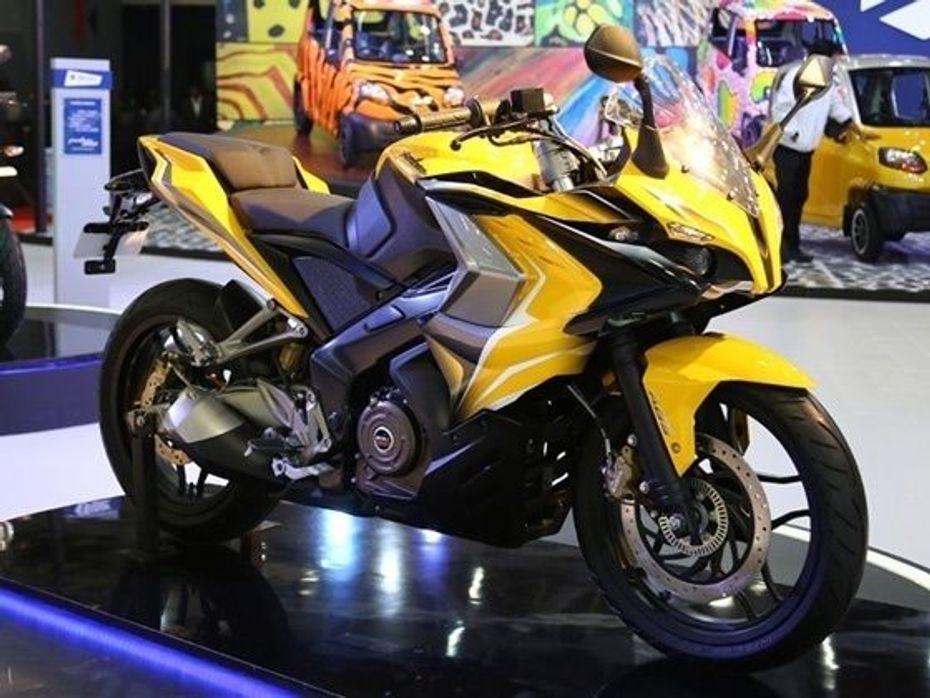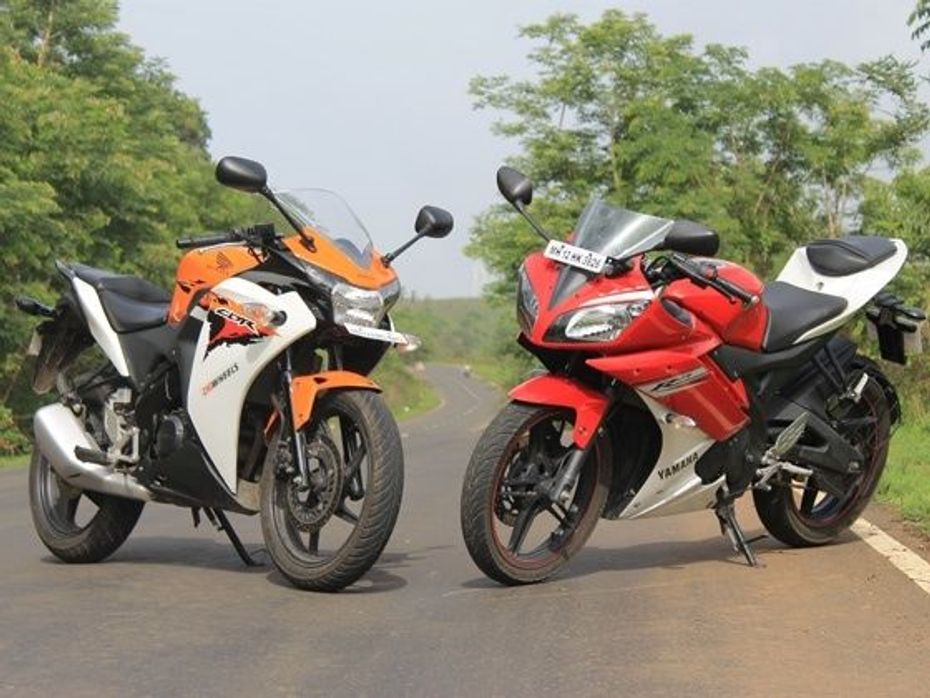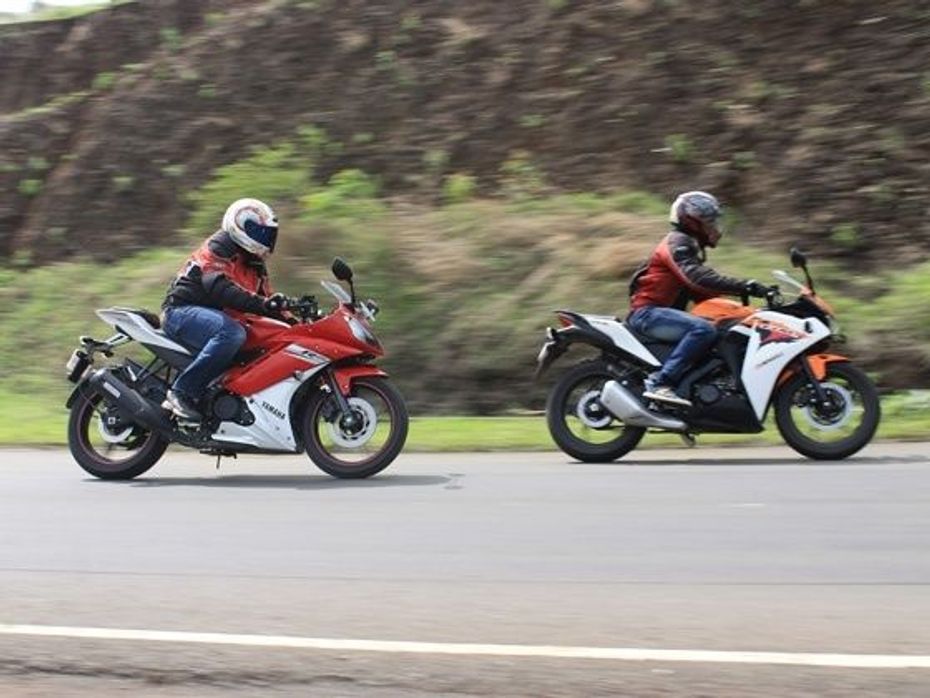
Bajaj Pulsar RS200 vs Rivals: ZigWheels Comparison Video
- May 19, 2015
- Views : 52775


Engine:
Performance is among the most important factors in this segment of motorcycles. The Bajaj Pulsar RS200 leads the charge in terms of power output owing to its displacement benefit. Powering the Bajaj Pulsar RS200 will be a 199.5cc, liquid-cooled, fuel-injected powerplant producing 24.4 PS of power at 9,500rpm and 18.6 Nm of torque at 8,000rpm. Power is transmitted to the rear-wheel via a six-speed gearbox on all the three motorcycles. The Honda CBR 150R comes second in terms of power output as the liquid-cooled, single-cylinder motor churns out 18.3PS of peak power and 12.6Nm of maximum torque. The Yamaha R15 version 2.0 is the least powerful among the trio as the 149.8cc, single-cylinder and fuel injected mill produces 17PS but it has higher torque rating than the Honda offering at 15Nm. Given the fact that the Pulsar RS200’s motor will be based on the 200NS we can assume that refinement levels of the Honda and Yamaha offering would be better than it.

Features:
The Bajaj Pulsar RS200 is the most loaded motorcycle with respect to features in comparison to the Honda CBR 150R and Yamaha R15 version 2.0. The Bajaj Pulsar RS200 will be offered with twin projector lamps that are much superior to the standard headlamps as seen on the Japanese duo. The Bajaj Pulsar RS200 will also be equipped with ABS as an option making it the only Bajaj offering to offer the above as an option. Instrument console on all the three motorcycles is a part-analogue-part-digital instrument console with an analogue tachometer. Switch gear quality on all the above bikes are good but the Pulsar offering gets backlit switches. The Honda CBR 150R loses out on an engine kill switch which is unacceptable at this pricing. In terms of build quality, the Yamaha R15 version 2.0 seems to be the most well put together bike among the trio along with fit and finish.

Dimensions and cycle parts:
All the motorcycles employ telescopic front forks and a monoshock setup at the rear to handle suspension duties. Braking is provided by disc brakes at front and rear on the trio while the Bajaj Pulsar RS200 will be the only bike to offer ABS as an option. The Bajaj Pulsar RS200 employs a steel perimeter frame while the Honda CBR 150R uses a diamond type frame while the R15 version 2.0 features a Delta box frame. The Honda CBR 150R has the shortest wheelbase at 1,305 followed by the Yamaha offering at 1,345mm whereas the Pulsar RS200 is the longest at 1,363mm. The Yamaha R15 is the lightest motorcycle at 136kg whereas the Honda CBR150R comes a close second at 138kg and the Bajaj Pulsar RS200 is the heaviest as t tips the scale at 151kg almost 6kg more than the 200NS.

Pricing and fuel efficiency:
If ridden sedately all the three motorcycles are good enough to return a fuel efficiency figure of around 40kmpl in real world conditions. The Honda CBR 150R has the highest fuel tank capacity at 13 litres whereas the Pulsar RS200 and Yamaha R15 version 2.0 have a 12 litre fuel tank. Bajaj is renowned for their cut-throat and aggressive pricing so expect the Bajaj Pulsar RS200 to be priced around Rs 1.15 lakh. The Yamaha R15 version 2.0 is the cheapest of the lot with a sticker price of Rs 1.10 lakh and the Honda CBR 150R is the most expensive offering among the trio at Rs 1.22 lakh.

Bajaj Pulsar RS200 vs Rivals: ZigWheels Comparison Video

Bajaj Pulsar RS200 vs Yamaha R15 vs Hero Karizma ZMR Comparison Review

Hero Xtreme 200R vs Bajaj Pulsar NS 200 vs TVS Apache RTR 200 4V:...

Bajaj Pulsar NS 200 vs TVS Apache RTR 200: Comparison Road Test Review

Yamaha R15 V4 vs Other Faired Bikes - Specifications Compared

Yamaha YZF-R15 V4 vs Bajaj Pulsar RS200: Specification Comparison

Here’s How The New MT-15 Fares Against The Baby Duke

Bajaj Dominar 250 vs KTM 250 Duke BS6: Spec Comparison

2019 Bajaj Dominar 400 vs KTM 390 Duke: Comparison Review

2019 Bajaj Dominar 400 vs KTM 390 Duke: Picture Gallery
 TVS Apache RTR 200 4V
TVS Apache RTR 200 4V
 Yamaha FZ-FI Version 3.0
Yamaha FZ-FI Version 3.0
 Bajaj Pulsar NS200
Bajaj Pulsar NS200
 Yamaha R15 V4
Yamaha R15 V4
 Yamaha MT 15 V2.0
Yamaha MT 15 V2.0
India's largest automotive community
 Bajaj Pulsar NS200
Rs. 1.58 Lakh
Bajaj Pulsar NS200
Rs. 1.58 Lakh
 Bajaj Pulsar 125
Rs. 83,846
Bajaj Pulsar 125
Rs. 83,846
 Bajaj Pulsar NS 125
Rs. 1.01 Lakh
Bajaj Pulsar NS 125
Rs. 1.01 Lakh
 Bajaj Pulsar NS160
Rs. 1.47 Lakh
Bajaj Pulsar NS160
Rs. 1.47 Lakh
 Bajaj Pulsar N160
Rs. 1.33 Lakh
Bajaj Pulsar N160
Rs. 1.33 Lakh
 Bajaj Chetak
Rs. 1.20 Lakh
Bajaj Chetak
Rs. 1.20 Lakh
![Bajaj Chetak [2020 - 2024] Bajaj Chetak [2020 - 2024]](https://media.zigcdn.com/media/model/2024/Sep/bajaj-chetak-2025-right-side-view_135x90.jpg) Bajaj Chetak [2020 - 2024]
Rs. 99,998
Bajaj Chetak [2020 - 2024]
Rs. 99,998